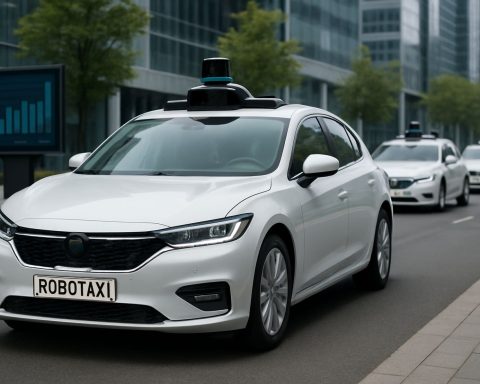- Scientists discovered ancient sediments beneath the Baltic Sea containing dormant life, revealing insights into Earth’s history and life’s resilience.
- Biologists revived Skeletonema marinoi, a diatom species dormant for 7,000 years, showcasing extraordinary survival strategies.
- This discovery provokes questions about life’s ability to endure in suspended states, emphasizing resilience against time.
- The James Webb Space Telescope (JWST) explores protoplanetary disks, challenging existing planet formation models.
- JWST reveals large dust grains and aromatic hydrocarbons, offering insights into the complex chemistry of planetary birth environments.
- Both Earth and space research highlight life’s perseverance and human curiosity, expanding our understanding of life and the universe.
Deep beneath the tumultuous waves of the Baltic Sea, scientists have unearthed a time capsule in the form of ancient sediments. These layers, forged thousands of years ago, contain dormant life forms waiting patiently for their moment to reawaken. This remarkable discovery illuminates our planet’s past and challenges the boundaries of life as we understand it.
Amidst the swirling depths of the Eastern Gotland Basin, biologists unveiled the astonishing resurrection of a diatom species, Skeletonema marinoi. This unassuming organism, no larger than the width of a human hair, lay dormant for an eye-popping 7,000 years, preserved in an anoxic cocoon of sediment. Reviving to life, these diatoms display an incredible vitality, offering a unique glimpse into survival strategies honed by nature over millennia.
These microscopic time travelers not only serve as a window into ancient ecosystems but also pose profound questions about life’s ability to endure in suspended states. The Skeletonema marinoi strains, visually striking even under the microscope, vary in age from a mere three years to several thousand, each painting a picture of resilience against the sands of time.
As researchers delve into these ancient sediments, another scientific frontier beckons—the vast expanses of the cosmos where the James Webb Space Telescope (JWST) is unravelling the mysteries of protoplanetary disks. The icy depths of these stellar nurseries present an enigmatic dance of dust and ice, challenging our preconceived notions of how planets form.
The JWST’s sharp gaze has dissected the spectral fingerprints of these disks, revealing ice absorption bands that defy traditional models of radiative transfer. Giant triaxial dust grains, some as large as grains of sand, swirl in these frigid cosmic theaters, scattering light in ways never seen before. This ambitious undertaking, choreographed by a global team of astronomers, seeks to piece together the puzzle of planetary birth, ice by ice, dust by dust.
Yet, the story deepens as the JWST detects winds carrying aromatic hydrocarbon signatures, shedding light on the complex chemistry at work in these celestial forges. This X-shaped wind, visible in infrared snapshots, whispers tales of materials whisked away from the disk, perhaps seeding the cosmos with the building blocks of life.
Both on Earth and in space, the narrative of resilience and exploration continues to challenge our intellect and expand our horizons. Whether warming ancient diatoms to life from the cold, dark depths or peering into the enigmatic crucibles of creation far beyond our planet, these pursuits remind us of the extraordinary perseverance of life and the boundless curiosity of humankind. The takeaway, it seems, is clear: life is tenacious, and the universe—vast in its mysteries—awaits our eager exploration.
Unlocking Ancient Secrets: How Resurrected Diatoms and Cosmic Discoveries Expand Our Horizons
Introduction: Reviving Earth’s Past and Understanding Cosmic Mysteries
The unearthing of ancient sediments in the Baltic Sea not only sheds light on Earth’s distant ecosystem but also resonates with our ongoing quest to understand the cosmos. The remarkable revival of the diatom species, Skeletonema marinoi, after being dormant for 7,000 years, opens up new avenues of exploration in both terrestrial and extraterrestrial contexts.
Key Insights and Implications from Dormant Diatoms
1. Microbial Survival Mechanisms: These diatoms demonstrate the incredible resilience of life, possibly holding clues to microbes’ survival in extreme conditions. Understanding these mechanisms can aid astrobiologists in exploring the possibility of life on other planets, particularly where conditions are harsh and life may be dormant.
2. Biodiversity Conservation: As these ancient organisms are studied, they offer insights into past climate conditions. This can provide valuable data for biodiversity conservation efforts, helping scientists predict how current ecosystems might adapt to climate change.
3. Biotechnology Applications: The study of dormant diatoms might also inspire new biotechnologies. For instance, leveraging their unique survival strategies could lead to advancements in fields like cryopreservation and biotechnology.
Cosmic Frontier: Insights from the James Webb Space Telescope (JWST)
1. Protoplanetary Disk Observations: By investigating protoplanetary disks, the JWST is providing unparalleled data on the formation of planetary systems. These findings are crucial for refining models of planet formation and understanding the role of dust and ice in celestial mechanics.
2. Astrochemistry and Life’s Building Blocks: The detection of aromatic hydrocarbon signatures by the JWST suggests complex chemical processes occurring in space. This could mean that the basic organic compounds necessary for life might be more common in the universe than previously thought.
3. Implications for Exoplanet Studies: The nuanced information about dust grain scattering and wind activities in space can inform researchers about atmospheric conditions on exoplanets, which is key for assessing their habitability.
Pressing Questions and Practical Applications
– What Does This Mean for Life in Extreme Conditions? Understanding ancient diatoms could improve how we think about life sustainability in harsh environments, such as the deep sea or space habitats.
– How Can We Use This Knowledge in Technology and Conservation? The inherent adaptability seen in these diatoms might inspire technological innovations focused on sustainability and resilience.
Quick Tips and Actionable Recommendations
– Stay Informed: Keep updated with the latest findings from oceanic and space research. This knowledge can empower educational and scientific pursuits.
– Support Interdisciplinary Research: Encourage collaboration across fields—combining marine biology with astrobiology can lead to groundbreaking discoveries.
Related Resources
– For more on space exploration and astronomical studies, explore the official NASA website: NASA.
– Learn about oceanic ecosystems and conservation efforts through the National Oceanic and Atmospheric Administration: NOAA.
In conclusion, the study of resurrected diatoms alongside the JWST’s cosmic discoveries reinforces the fascinating narrative of resilience and exploration, urging humankind to pursue curiosity and innovation across both terrestrial and celestial domains. The journey of understanding life and the universe has just begun, with many chapters yet to be unveiled.












